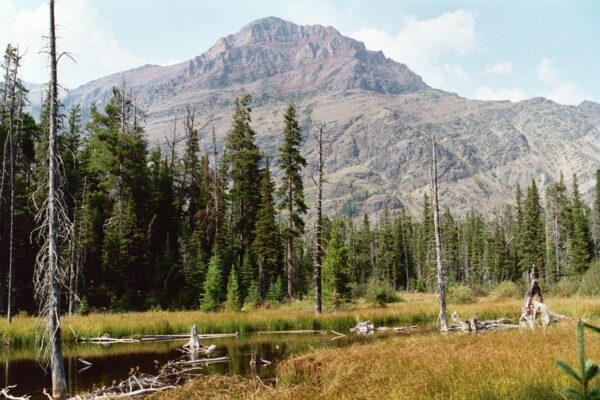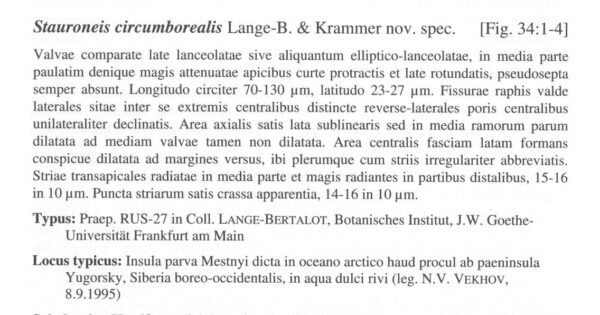Stauroneis circumborealis
-
Category
-
Length Range81-148 µm
-
Width Range20-31 µm
-
Striae in 10 µm14-16
-
ContributorLoren Bahls - Dec 2011
-
ReviewerSarah Spaulding - May 2012
Identification
Description
Valves are elliptic-lanceolate with short and broadly rounded apices. The axial area is wide, about one-fifth the width of the valve and 4-5 times wider than the raphe. The stauros is also wide and expands towards the valve margins. Short striae are often found at the margins of the stauros. The raphe is lateral and is strongly curved near the proximal ends. Central pores are large and tear drop shaped. Terminal raphe fissures are hooked towards the same side as the proximal ends. Striae are radiate throughout, more so near the apices. Areolae are distinct and number 15-18 in 10 µm.
Autecology
Stauroneis circumborealis is widely distributed in small lakes and ponds in the Northern Rockies. In these waters pH ranges from 6.0 to 7.6 and specific conductance ranges from 8 to 117 µS/cm. This taxon has also been reported from the Russian Arctic (Lange-Bertalot & Genkal 1999) and from the Zackenberg area of Greenland (Van de Vijver et al. 2004).
-
Size Range, µm3
-
Motility
-
Attachment
-
Habitat
-
Colony
-
Waterbody
- Learn more about this
Original Description
Valvae comparate late lanceolatae sive aliquantum elliptico-lanceolatae, in media parte paulatim denique magis attenuatae apicibus curte protractis et late rotundatis, pseudosepta semper absunt. Longitudo circiter 70-130 µm, latitudo 23-27 µm. Fissurae raphis valde laterales sitae inter se extremis centralibus distincte reverse-laterales poris centralibus unilateraliter declinatis. Area axialis satis lata sublinearis sed in media ramorum parum dilatata ad mediam valvae tamen non dilatata. Area centralis fasciam latam formans conspicue dilatata ad margines versus, ibi plerumque cum striis irregulariter abbreviatis. Striae transapicales radiatae in media parte et magis radiantes in partibus distalibus, 15-16 in 10 µm. Puncta striarum satis crassa apparentia, 14-16 in 10 µm.
-
AuthorLange-Bert. and Krammer 1999
-
Length Range70-130 µm
-
Width23-27 µm
-
Striae in 10µm15-16
Citations & Links
Citations
Links
-
Index Nominum Algarum
Cite This Page
Bahls, L. (2011). Stauroneis circumborealis. In Diatoms of North America. Retrieved April 16, 2024, from https://diatoms.org/species/stauroneis_circumborealis
Responses
The 15 response plots show an environmental variable (x axis) against the relative abundance (y axis) of Stauroneis circumborealis from all the stream reaches where it was present. Note that the relative abundance scale is the same on each plot. Explanation of each environmental variable and units are as follows:
ELEVATION = stream reach elevation (meters)
STRAHLER = distribution plot of the Strahler Stream Order
SLOPE = stream reach gradient (degrees)
W1_HALL = an index that is a measure of streamside (riparian) human activity that ranges from 0 - 10, with a value of 0 indicating of minimal disturbance to a value of 10 indicating severe disturbance.
PHSTVL = pH measured in a sealed syringe sample (pH units)
log_COND = log concentration of specific conductivity (µS/cm)
log_PTL = log concentration of total phosphorus (µg/L)
log_NO3 = log concentration of nitrate (µeq/L)
log_DOC = log concentration of dissolved organic carbon (mg/L)
log_SIO2 = log concentration of silicon (mg/L)
log_NA = log concentration of sodium (µeq/L)
log_HCO3 = log concentration of the bicarbonate ion (µeq/L)
EMBED = percent of the stream substrate that is embedded by sand and fine sediment
log_TURBIDITY = log of turbidity, a measure of cloudiness of water, in nephelometric turbidity units (NTU).
DISTOT = an index of total human disturbance in the watershed that ranges from 1 - 100, with a value of 0 indicating of minimal disturbance to a value of 100 indicating severe disturbance.

Stauroneis circumborealis
- Valves large, elliptic-lanceolate
- Apices short and broadly rounded
- Axial area 4-5 times wider than raphe
- Stauros wide
- Proximal raphe ends strongly curved
Stauroneis circumborealis has large elliptic-lanceolate valves with short, broadly rounded apices. The axial area is 4-5 times wider than the raphe and the stauros is wide. Proximal raphe ends are strongly curved.
 Diatoms of North America
Diatoms of North America







